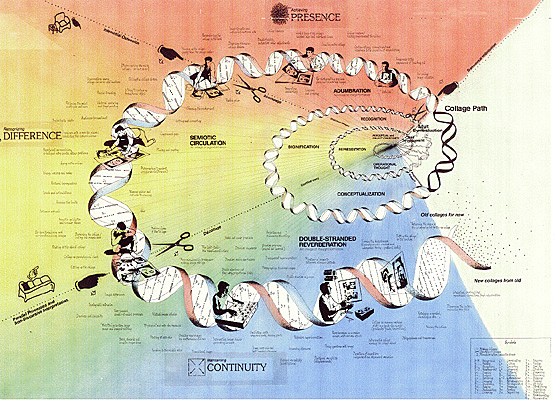Thursday, August 14, 2008
Theory and therapy
[Thanks to nora for this link]
“Everything had broken down and new things had to be made out of the pieces. Collage was like an image of the revolution within me—not as it was but as it might have been.” —Kurt Schwitters
The CIA’s LSD experiment ended my father’s life and profoundly distorted my own. Even before I knew that LSD and the CIA were involved in producing these effects I had already begun a research program to counteract them. I was looking for a formative psychological technique that could exert a force opposite to the deformative one I could feel but whose source I could not yet locate and name—a sort of antitoxin for psychic trauma. I discovered such a technique in what I came to call “the collage method.”*
A medium whose essence is the overlapping of images, collage is literally based upon the logic of the coverup. In collage, however, this logic works not as a technique for blocking thought, but rather as a model of the mind’s fundamental process of representation and symbolization.
The story of this other research program functions as a psychological counterplot in the book I am writing. It crisscrosses the CIA plot in surprising and often ironic ways. In the course of my own search the collage method served several functions. I employed it as a detective's microscope in the search for a solution to the mystery of my father’s death, and as an open system for symbolic development, a psychological incubator that represented the converse of the CIA’s closed system of manipulative mind-control experiments. Having come to this technique largely in response to the trauma of my father's death, I think of the collage method as a serum extracted from a disease.
My book seeks to provide a bridge between an horrendous, shattering episode and a vision that transcends it. The aim is to move beyond both CIA scandal and personal trauma by making a contribution to historical consciousness and to psychological theory and clinical method. Collage figures centrally in this aspiration because this medium comprises a membrane between collective and individual representations, and between mind-control (enslavement to static images or to a pre-programmed, fixed code) and mental freedom (the capacity for continuous symbolization and psychic re-creation).
The collage process as symbolic re-creation.
The lattice-work of images in a collage readily suggests a maze in which one becomes lost or trapped. But the collage-process—the sequence of operations by which a collage is made and transformed—suggests a developmental spiral. A spiral is the form that, in Sartre's words, enables one to “pass again and again by the same points, but at different levels of integration and complexity.” Hence a spiral is the geometric form that represents the logic of development.
The capacity of collage to reconcile the notions of maze and spiral—and thereby to support the resumption of development—is not as surprising as it sounds. Historically these forms were not as distinct as they appear today. In ancient Greece both maze and spiral were subsumed in the concept of the labyrinth, which intially signified a spiral through which one could return after reaching the center. The idea here is that collage-making provides a model of open personal change based upon the notion of a re-creative spiral. The collage process transmutes the maze-like experience of personal fragmentation and disorientation into the media of personal renewal.
Discussion of the Collage Method continues: “Chaos, Creation, & Collage”
© Eric Olson, 2000
Subscribe to Posts [Atom]

